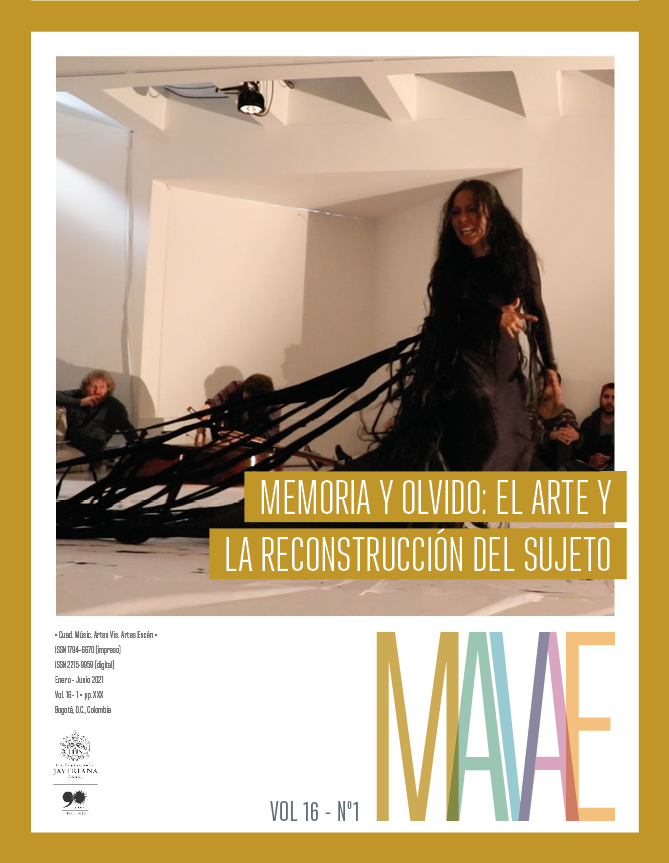Resumen
En este trabajo presento la relación entre destrucción y huella para indagar cómo se puede reconstruir materialmente aquello que ha sido destruido. Analizo la obra visual Stellar (2015), del artista peruano Giancarlo Scaglia, y la película Nostalgia de la luz (2010), del director chileno Patricio Guzmán, para proponer cómo ambos artefactos plantean la destrucción como la producción de otras materialidades (en forma de huellas) capaces de dar trazos sobre su previa forma y hacer factible un tipo de sentido político que la totalidad material no hace posible. Para ello, encuentro en estos artefactos diferentes tecnologías de mediación que interrogan la legibilidad de las huellas. Stellar utiliza la técnica del frottage como modo de hacer presente la ausencia por medio del calco y revela en su materialidad vestigios de un evento del pasado y las dificultades que limitan su memorialización. Nostalgia de la luz, en cambio, propone tanto un entrenamiento visual sobre cómo leer las fisuras de la destrucción material, resultado de políticas estatales de borramiento, como una sofisticada revisión sobre las complejidades de las políticas de archivación de huesos humanos como formas de violencia que configuran otras huellas a ser leídas. De esta manera, los dos objetos que estudio en este artículo me permiten plantear formas de entender la destrucción como un proceso del cual solo podemos leer mediados por huellas. Las huellas de destrucción no solo permiten reconstruir una historia, sino que revitalizan una memoria que resiste a pesar de su borradura ligada a políticas estatales de la desmemoria. Leer las huellas de la destrucción significa invertir los procedimientos de la desmemoria política, aunque ello no implique resolver un conflicto del pasado o cerrar el duelo, sino más bien la posibilidad de recordar pese a todo.
Alvarado Jourde, Gladys. 2014. El Frontón: Demasiado pronto / demasiado tarde. Junio 1986-marzo 2009. Lima: Micromuseo.
Andermann, Jens. 2007. The Optic of the State: Visuality and Power in Argentina and Brazil. Pittsburgh: University of Pittsburgh Press.
Benjamin, Walter. 2013. Libro de los pasajes. Madrid: Akal.
Bennett, Jane. 2010. Vibrant Matter: A Political Ecology of Things. Durham: Duke University Press.
CIDH (Comisión Interamericana de Derechos Humanos). (1991). Memoria: el caso El Frontón”. Consultado: 5 de enero 2020. www.corteidh.or.cr/docs/casos/neyrayal/fmemcidh.pdf
De Kooning, Willem, Excavation, 1950. Óleo y esmalte sobre lienzo, The Art Institute of Chicago, Chicago.
Foster, Hal. 1999. Vision and Visuality. Nueva York: New Press.
Foucault, Michel. 2010. El cuerpo utópico: Las heterotopías. Buenos Aires: Nueva Visión.
Gallegos, Juana. 2015. “El pintor de El Frontón”. La República, 21 de mayo de 2019. Consultado: 5 de enero 2020. https://larepublica.pe/tendencias/192208-el-pintor-de-el-fronton/
Guzmán, Patricio. Nostalgia de la luz. 2010; Chile: Atacama Productions, Blinker Filmproduktion, Westdeutscher Rundfunk, Cronomedia, 2010.
Haya de la Torre, Agustín. 1987. El retorno de la barbarie: La matanza en los penales de Lima en 1986. Lima: Bahía.
Hirsch, Marianne. 2008. “The Generation of Postmemory”. Poetics Today 29 (1): 103-128. https://doi.org/10.1215/03335372-2007-019.
La República. 2016. “Matanza de El Frontón: Otros siete cuerpos identificados son entregados a familiares”, 4 de agosto de
Consultado: 5 de enero 2020 https://larepublica.pe/politica/791290-matanza-de-el-fronton-otros-siete-cuerposidentificados-son-entregados-familiares/.
Mirzoeff, Nicholas. 2011. The Right to Look: A Counterhistory of Visuality. Durham: Duke University Press.
Nora, Pierre. 1989. “Between Memory and History: Les Lieux de Mémoire”.Representations, 26, 7-24. doi:10.2307/2928520.
Pindyck, Maya. 2018. “Frottage as Inquiry”. International Journal ofEducation Through Art 14 (1): 13-25. https://doi.org/10.1386/eta.14.1.13_1.
Povinelli, Elizabeth A. 2016. Geontologies: A Requiem to Late Liberalism. Durham: Duke University Press.
Richard, Nelly. 2002. “La crítica de la memoria”. Cuadernos de Literatura 8 (15): 187-193.
Sarlo, Beatriz. 2005. Tiempo pasado: Cultura de la memoria y giro subjetivo. Una discusión. Buenos Aires: Siglo XXI.
Scaglia, Giancarlo. Stellar, 2015. Frottage y tinta de grabado sobre papel japonés, Sala Luis Miró Quesada Garland, Lima (24 abril 2015).
Scaglia, Giancarlo, Catálogo de piedras, 2015. Sala Luis Miró Quesada Garland (24 abril 2015).
Scaglia, Giancarlo, Libreta de trabajo, 2015. Libreta de trabajo con dibujo de constelación de escombros, Galería Patricia Ready, Santiago (5 julio 2017).
Sekula, Allan. 1986. “The Body and the Archive”. October 39: 3-64. DOI:10.2307/778312
Slifkin, Robert. 2011. “The Tragic Image: Action Painting Refigured”. Oxford Art Journal 34 (2): 227-46. https://doi.org/10.1093/oxartj/kcr019

Esta obra está bajo una licencia internacional Creative Commons Atribución 4.0.
Derechos de autor 2021 Alejandro Martinez


